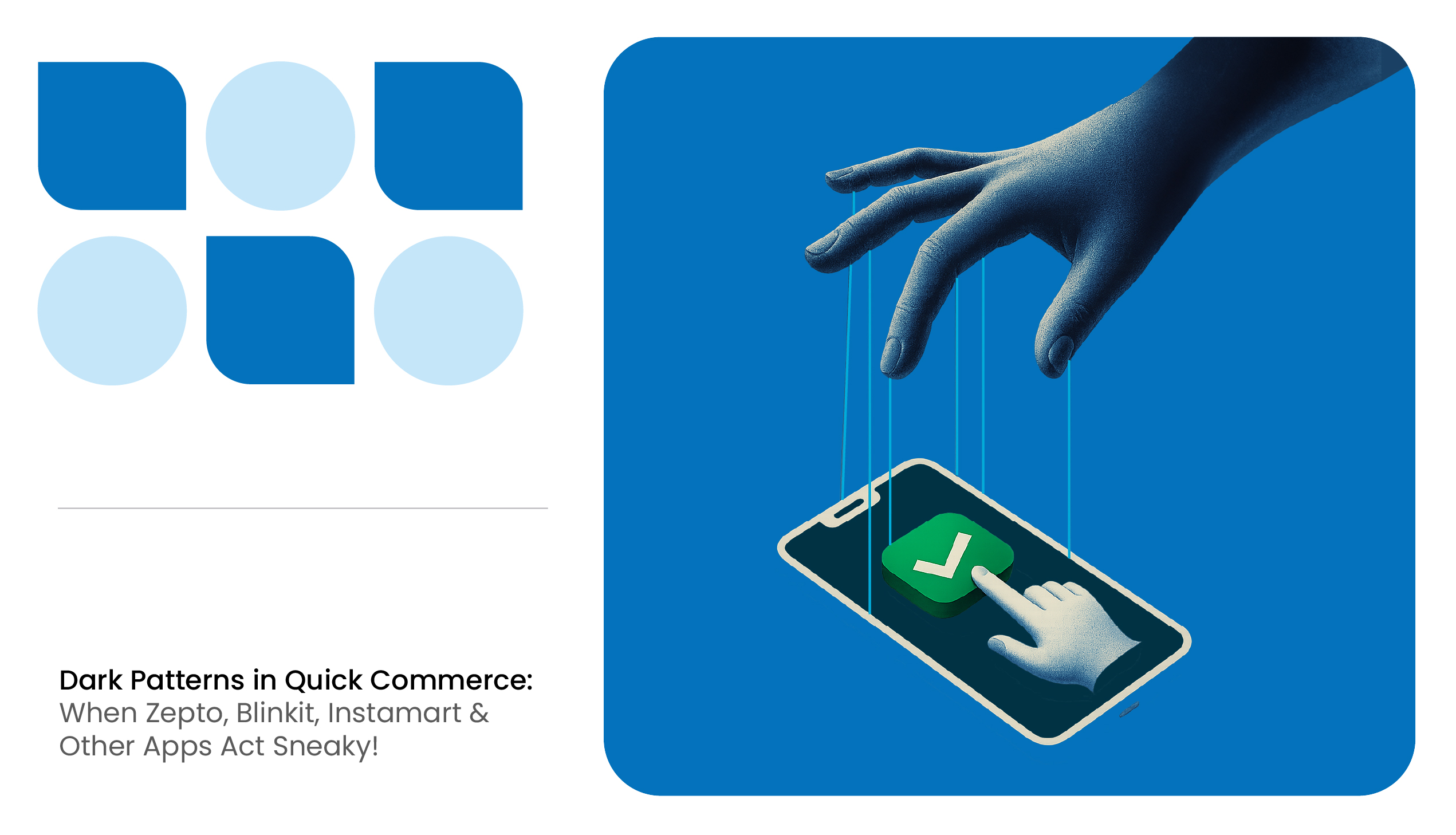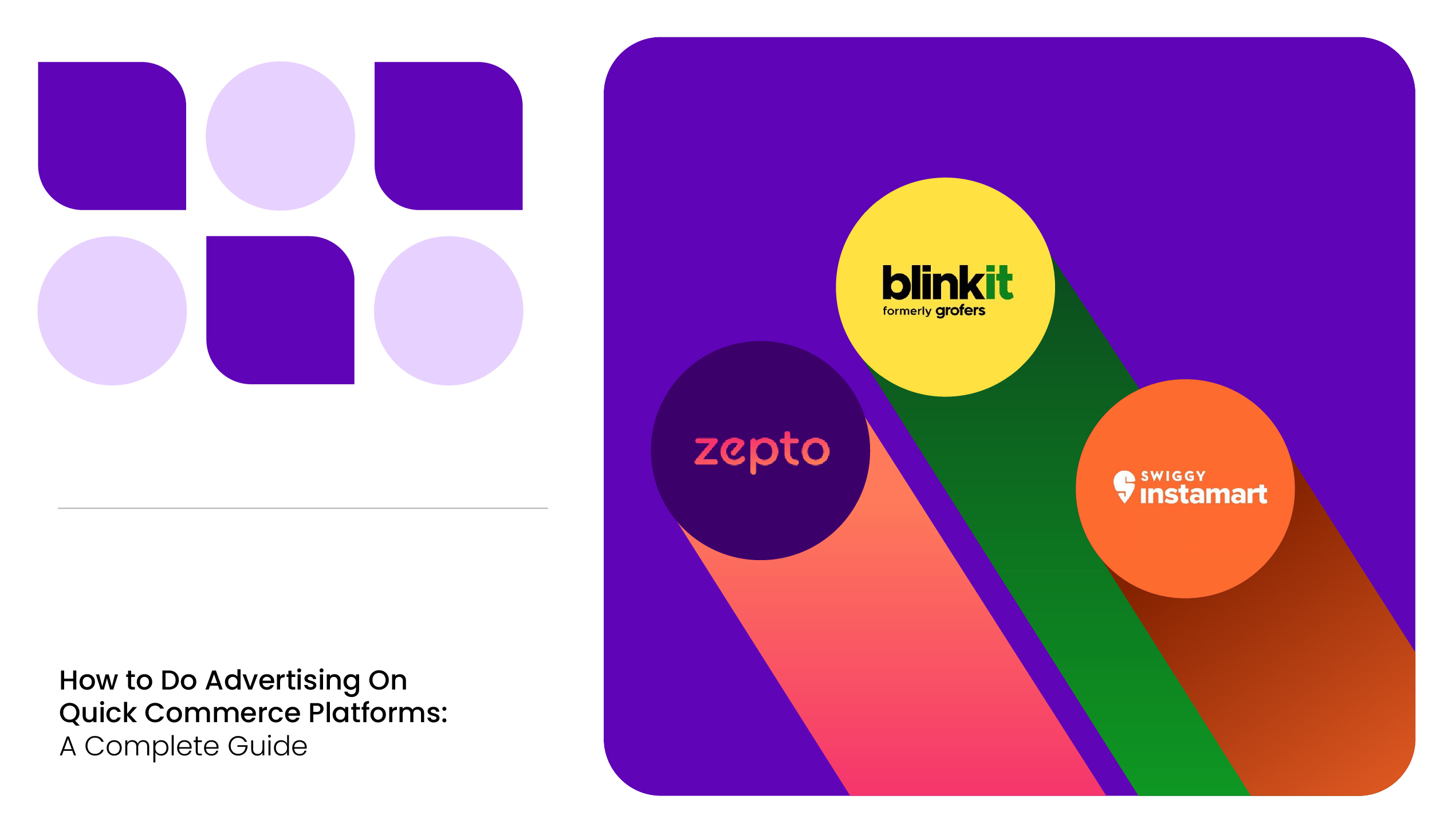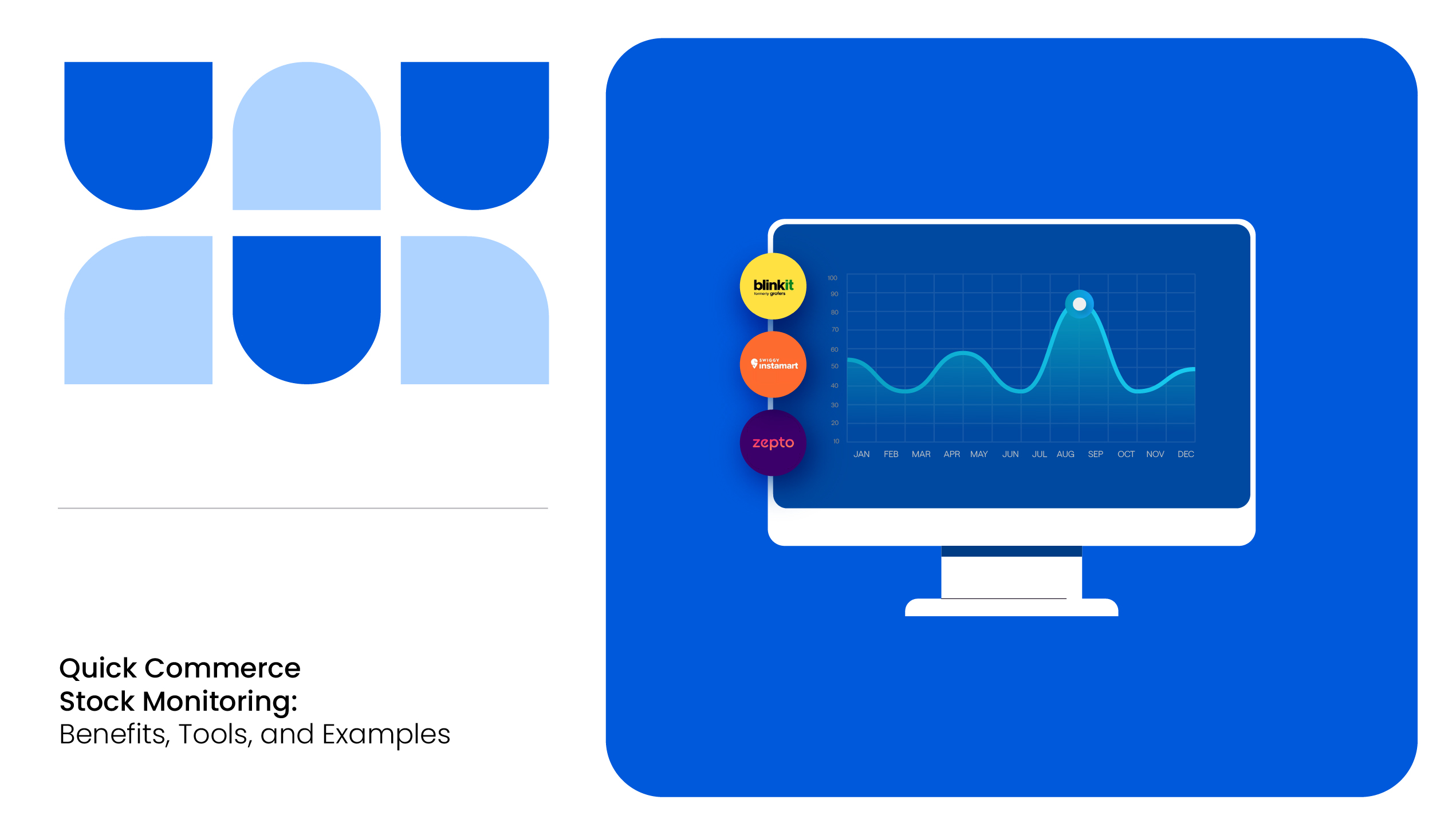Quick commerce isn’t just changing how people shop; it’s rewriting the rules for FMCG brands. Platforms like Zepto move fast. Prices can fluctuate significantly within hours. Flash discounts appear and vanish before you can react. Stock that’s available in the morning might be gone by lunch.
And the scale is too big to ignore. India’s quick commerce market is already worth ₹64,000 crore in 2025 and is set to touch ₹2 lakh crore by 2028. Zepto has grown its market share from 15% in 2022 to nearly 29% in 2024, making it a major sales channel for urban grocery buyers.
For brands, this creates a high-stakes challenge: if you can’t see what’s happening on Zepto in real-time, your pricing, stock, and competitors’ moves, you’re reacting too late. Manual tracking isn’t just slow; it’s almost impossible at scale.
This is where a Zepto price tracker comes in. In this guide, we’ll show you how to monitor prices, discounts, and stock on Zepto to protect your margins, outpace competitors, and capture more sales.
Why is it Hard to Monitor Prices on Zepto?
Staying on top of prices and stock on Zepto isn’t easy. Here are the key challenges that make Zepto price monitoring difficult for brands:
Zepto Changes Prices Often
Zepto employs dynamic pricing strategies, meaning the cost of products can fluctuate throughout the day. High-demand items become more expensive during peak hours and drop in price during off-peak times.
This frequent price change makes it difficult for brands to determine the current prices of their products and those of their competitors at any given moment.
Stock Availability is Unpredictable
Products on Zepto can go out of stock suddenly due to surges in demand or supply issues. A product might be available in the morning in a dark store but be sold out by afternoon. Without automated alerts, brands may not realize their item is unavailable to shoppers, leading to lost sales.
Lack of Competitive Visibility
Zepto doesn’t provide an easy way to see all competitor pricing and promotions in one view. When brands have to manually check each rival product, they could miss an opportunity to respond when a competitor drops their price or offers a significant discount, until it’s too late.
Zepto’s City-Level Complexity
Zepto has a hyper-local approach, catering to specific neighborhoods and ensuring rapid deliveries. Prices and stock can vary by city or zone, adding another layer of complexity.
For example, a popular grocery item might cost significantly more in Bengaluru than in Delhi. Likewise, a product could be in stock in one city but unavailable in another. Brands need to monitor multiple cities to get the whole picture.
Flash Discounts & Promotions Go Undetected
Zepto often runs flash sales, limited-time discounts, or app-exclusive coupon deals. These promotions last only a few hours or a day. If you’re not constantly watching, you can easily miss these short-term discount events. Undetected, such promotions can skew sales and market share before you even know they happened.

What does the MetricsCart Zepto Price Tracker Monitor?
To address these pain points, MetricsCart offers a dedicated Zepto price monitoring tool that provides brands with 360° visibility into Zepto’s pricing and stock data. Here’s what the MetricsCart Zepto Price Tracker monitors:
Price Range Distribution
The price range distribution feature in the MetricsCart Zepto price tracker displays the number of products that fall within specific price brackets, such as ₹9–30, ₹30–106, ₹106–182, and so on. This helps brands understand how products are priced across Zepto’s catalog at scale.
![]()
For example, if most products in a category fall between ₹30 and ₹106 (as the data currently shows), it signals a high-density, high-competition price zone. On the other hand, a sparse count in the ₹400+ range suggests room for premium positioning or category gaps.
With MetricsCart, brands can monitor real-time SKU pricing across cities, identify category-level pricing clusters, and benchmark their products against those of competitors.
Product Price Hike Monitoring
MetricsCart tracks products with the biggest price jumps over the past 30 days—helping brands spot unusual or strategic price increases in real time. For example, Nutraj Flax Seeds saw a 237% hike, while several other SKUs like Oye Happy’s products and Zepto Café beverages also reported hikes above 160%.
![]()
This level of visibility lets brands identify where prices are rising sharply due to input costs, seasonal demand, supply chain issues, or aggressive margin plays. It also helps monitor third-party sellers for unauthorized price inflation, which can impact brand trust and platform positioning.
Whether you’re benchmarking against competitors or evaluating the timing of your own price changes, this feature helps you stay informed and responsive.
Price Drop Monitoring
MetricsCart highlights products with the steepest price drops over a 30-day window offering instant visibility into sudden markdowns or clearance activity.
For instance, Bhoomi Farms’ Organic Chilli Green dropped by 92.8%, and branded items like EUME umbrellas and URBN power banks saw reductions of over 50%.
![]()
This helps brands track aggressive discounting by competitors, seasonal price cuts, or flash sale patterns. It’s beneficial for identifying when your product’s pricing is undercut in the market or if third-party sellers are slashing prices in ways that could impact your positioning.
With this feature, brands can react more quickly, protect their margins, and adjust promotional strategies based on real-time market behavior.
Category-Level Insights
Beyond individual SKUs, the Zepto price tracker aggregates data at the brand and category level. For instance, the top categories feature gives brands a clear view of average and median pricing across Zepto’s major categories.
Each bar shows how products in categories like Home Needs, Masala & Dry Goods, and Packaged Food are priced, helping brands spot premium or value-driven trends at a glance.
![]()
The ‘Atta, Rice, Oil & Dals’ category commands the highest average price at₹439.46. This signals a premium product mix or bulk-pack formats gaining traction in this category. Meanwhile, categories such as Masala & Dry Goods and Personal Care show lower average and median prices, aligning more with impulse and repeat purchases.
This helps determine whether your brand falls into a premium or mass-market zone, and adjust your portfolio accordingly by incorporating premium SKUs or bundles as needed.
Stock Availability Monitoring
The Zepto price monitoring tool constantly checks stock status for your SKUs across different cities/zones. You’ll immediately know if a product goes out of stock and its location. In the example shown, out of 10,169 products, 10,125 are available, indicating a strong in-stock rate of over 99%.
![]()
By monitoring stock availability, you can fix supply issues promptly or identify if competitors’ products are out of stock (which could be an opportunity for your brand). With regular tracking, brands can identify trends in availability such as whether certain SKUs run out more often, or if availability changes by time of day or city.
Discount Range Distribution
MetricsCart tracks how many products fall into each discount bracket on Zepto, such as 0–10%, 10–20%, 30–40%, and so on. The most common discount range is 0–10%, applied to 2,661 products, followed closely by 10–20%. This shows that mild discounting is the dominant strategy in quick commerce.
![]()
This discount distribution insight helps you understand the overall promotional intensity on Zepto, whether shallow discounts are the norm or if deep discounting is happening in your category. This enables you to identify areas where the competition is stronger and develop suitable discount strategies.
Top Discounted Products
![]()
The top discounted products feature lists the individual SKUs with the highest discount percentages on Zepto, giving brands visibility into extreme price drops. The tracker captures live data across all categories, such as Fire-Boltt smartwatches with discounts up to 95%, and accessories like USB cables, LED lights, and festive products all slashed by over 88%.
This helps brands stay alert to deep discounting that can distort pricing norms or erode product value. By surfacing the most heavily discounted SKUs on Zepto, teams can monitor competitors who frequently run steep offers.
For brands sold via third-party sellers, this feature also acts as a reputation safeguard, flagging unusually high discounts that could signal unauthorized pricing or brand misuse. Most importantly, it supports price floor planning by helping brands set guardrails on discounts and avoid triggering a price war.
Conclusion
Quick commerce isn’t a niche channel anymore; nearly one in three urban online shoppers now rely on platforms like Zepto for their groceries.
By tracking Zepto prices, discounts, and stock in real time, you can:
- React instantly to competitor promotions
- Prevent lost sales from stockouts.
- Keep pricing competitive across cities.
- Protect brand value against excessive discounting.
MetricsCart’s Zepto Price Tracker provides the visibility you need in a single dashboard. No manual checks. No missed opportunities. Just clear, actionable intelligence — so your brand can win on Zepto, every single day.
Turn Zepto Data Into Sales Wins.
FAQs
A Zepto price tracker is a tool or software that monitors Zepto’s platform for you, in real time. It tracks product prices, discounts, and stock availability on Zepto. For FMCG brands, a tracker provides a consolidated dashboard of all your products (and even those of your competitors), allowing you to view current prices, ongoing promotions, and stock availability.
Zepto uses dynamic pricing algorithms that adjust product prices based on demand, supply, and competition. Additionally, if a rival platform or seller lowers its price, Zepto might respond by adjusting its own price. This is to optimize sales and inventory, but it makes it hard for brands to keep track without a dedicated monitoring tool.
A Zepto price tracker offers several benefits for brands: it saves time by automating the monitoring process, ensures you never miss a critical change (like a sudden competitor discount or your product going out of stock), and provides data insights to inform your decisions.
Yes, a good Zepto price tracker such as MetricsCart keeps an eye on stock availability and discounts, not just base prices. It will alert you if a product goes out of stock on Zepto, so you can take action.You can typically see which products have the highest discounts at the moment, and the overall range of discounts in your category.
yes. By tracking Zepto, you can ensure your pricing is competitive, your products are visible and in stock, and you can capitalize on trends (or address problems) faster. It’s about staying proactive in the fast-paced digital marketplace to serve your customers better and drive sales growth.






